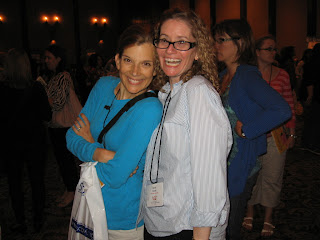Greg Pincus is a poet, author and social media guru who, through the wonders of social media (and his talent as a writer) got into the New York Times and landed a two book deal with Arthur A. Levine.
Alice Pope is the official blogger for SCBWI, Team Captain for SCBWI's Team Blog, and the former editor of the Children's Writers and Illustrator's Market Guide.

Here's a taste of their words of wisdom:
Greg: There's no one way - each person can follow their own path.
Alice: Just like getting published - it's the same with social networking.
Greg: Recognize that it's not always linear, but a good thing is a good thing. In advertising there's a rule of 7 times of being exposed to something before people buy it. If they see you 6 times via social media, and the 7th time they see your book is in a bookstore... that's good!
the effects are cumulativeYou are what you say and do - think of ebay, if someone has a 99% rating, then we trust that seller. Similarly we are all building our reputations online.
Be careful not to hurt yourself - be smart. Greg quoted Jenn Bailey who said that "to get something off the internet is like getting pee out of a swimming pool."
Alice reminded us that in all our interactions we want to ADD VALUE - how can you help? how can you further the conversation?
They've started to share examples of how authors and illustrators have been using social media to further their careers, including:
Readergirlz, five authors who created a safe online community for teenage girls - they're offering virtual author visits and a place for girls to talk books.
Lisa Yee's blog has helped her success and the character of Peepy has become a fun funny extension of her personality.
And me, Lee Wind, with my blog
"I'm Here. I'm Queer. What the Hell do I Read?" - which have given me an expertise in GLBTQ Kid Lit and a platform.
There are so many examples, great points and insights being offered.
Here's an amazing one!
Mitali Perkin's blog, where she talks about multicultural books for kids, even includes a post where she talks about and how through twitter she sold five of her books to India!
They're speaking about blog book tours now... Alice is sharing about
author Holly Cupala's book blog tour that she recently hosted one stop for on her SCBWI Blog.
Someone asked how you get Twitter followers, and Alice gave this great advice:
If you participate, people will notice you.
In answering a question about Facebook Fan Pages versus Personal Facebook Pages, Greg says: Everything you say and do online is PUBLIC. And stay active - people want to connect.
Another example of someone doing it right is
Cynthea Liu's recent book launch, where she raised money for a local school and adding that selfless focus was very successful for her.
As Greg says about his own
30 poets 30 days project, which highlighted poems of other people on his own poetry blog, you don't want to just talk about yourself all the time.
They're sharing so much beyond what I've been able to blog here - Greg and Alice really are Social Media Gurus!
I'll give Alice the final words here for us to remember:
Social Networking is not rocket science - it's just talking.
And as a bonus, Greg reads his poem "
I'm pretty well connected" to the room's applause.



















































